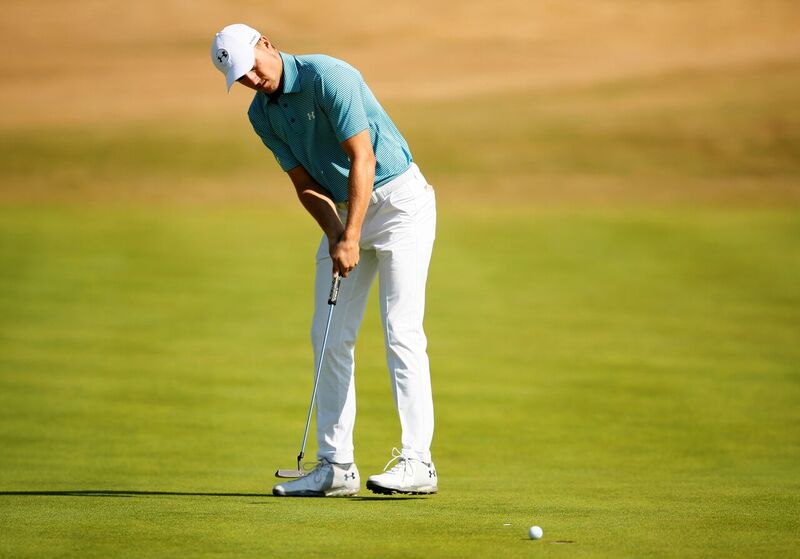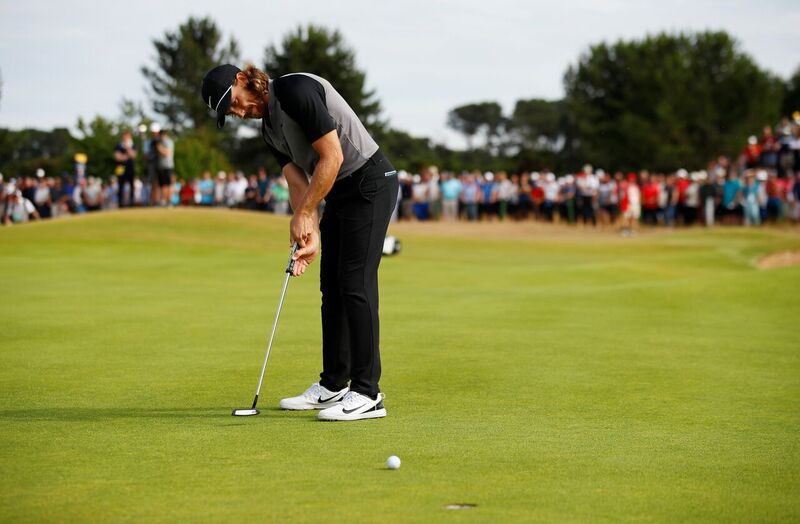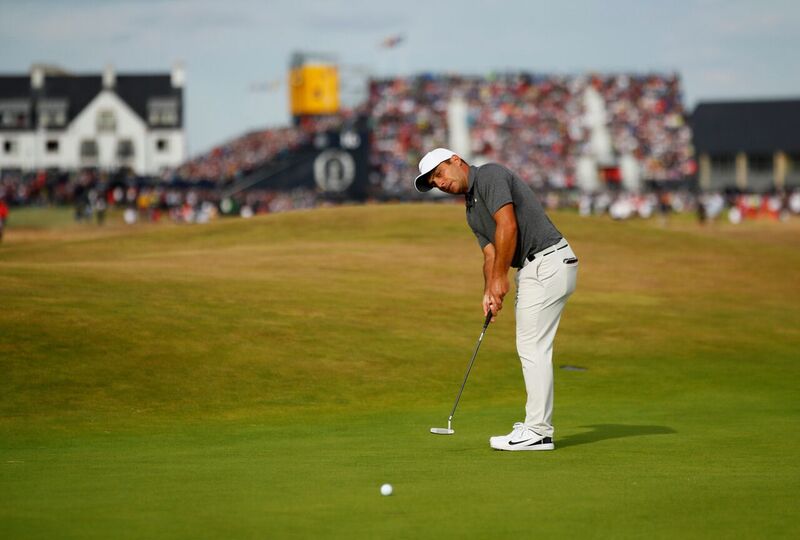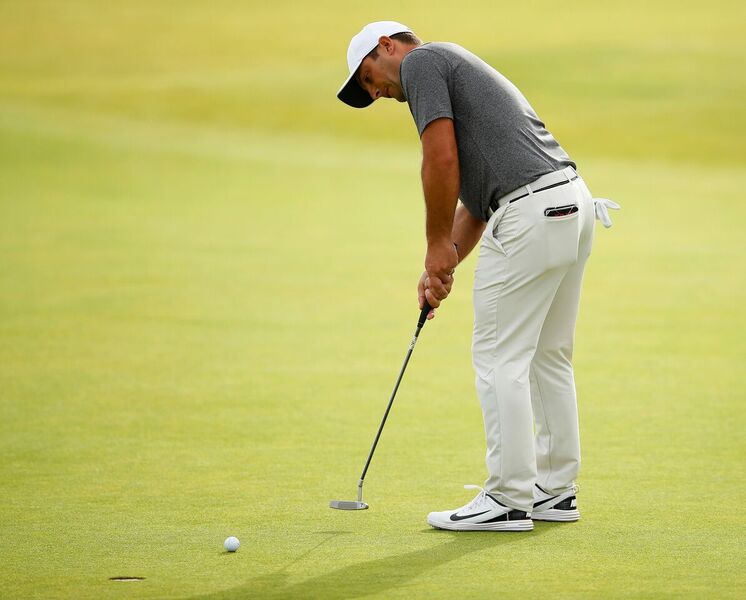Putting Factor – Phil Kenyon
Chief among the game’s current crop of putting gurus is 44-year-old Phil Kenyon, a former playing professional from Southport. At Carnoustie, Kenyon’s list of pupils pretty much resembled the leaderboard, with Tommy Fleetwood, Justin Rose, Rory McIlroy and a certain Francesco Molinari among his ‘regulars’.
Editor Richard Simmons invited Phil to identify some of the commonly-held ‘myths’ that hold regular players back on the greens – and the common sense behind Phil’s expert analysis just might make all the difference when you next get the opportunity to work on your stroke…
By Richard Simmons
Estimated reading time: 10 minutes
1. “ACCELERATE THE PUTTER-HEAD…”
Let’s kick this off with one of the most commonly-held myths of them all – that the ideal stroke, in order to achieve the most efficient strike, is one that sees the putter-head accelerate in the downswing and through the ball.
Stop and think about this for a moment in terms of your ability to control the speed at which the ball leaves the face; if the putter is accelerating in the downswing then the putter head is increasing in its velocity, gathering momentum. And if the speed of the putter is increasing as it meets the ball then it can be very difficult to control the precise speed at the moment of impact.
Putting Factor – Phil Kenyon
Controlling speed is a fundamental skill that characterises great putters – Jordan spite being one of the stand-out player in this department of the game. He strokes every putt with a wonderfully even tempo. A more constant speed at the bottom of your stroke will allow you to consistently control the speed of delivery at impact. The 3D data that we have collected actually shows that there are many great putters who exhibit little to no acceleration through the downswing – and some even decelerate slightly coming in to impact, the peak acceleration often being the first part of the downswing, not through impact itself!
Completing the stroke with an excessively long follow-through is a tell-tale sign of ‘over-acceleration’ – just watch Jordan Spieth next time he putts and you won’t see either.

Putting Factor – Phil Kenyon
2. “HIT IT OFF THE TOE OF THE PUTTER ON QUICK DOWNHILL PUTTS”
How often have you heard it said that hitting off the toe-end of the putter is the secret to ‘deadening’ impact, taking speed out of the equation on a very quick downhill putt? This is another widely-held misconception and one that a lot of amateur players tend to place a store of value in.
One thing is certain: off-centre hits transfer less energy to the ball than a perfectly-timed stroke at the same swing speed that strikes the ball out of the sweet-spot. So, yes, lining up on the toe would dull the strike and reduce speed. The problem you have, however, is that when you strike off-centre the putter-head is likely to twist, which can cause the ball to start off line, and it will also create what’s known as a ‘gear effect’, which changes the spin of the ball. The spin will affect the point of true roll and, as a consequence, the break it takes.
One of the truisms we work towards is that only consistent launch conditions create consistent predictability when it comes to green reading and speed control. Which is why as a putting specialist I recommend to all my students that they work on striking the ball from the sweet-spot on all putts – no matter how fast.
Putting Factor – Phil Kenyon

Putting Factor – Phil Kenyon
3. “THE PUTTING STROKE IS A PENDULUM”
Given the structure of the set-up and the metronomic-like quality we often talk about in a repeating action, it’s easy to see why the putting model is likened to a pendulum motion. But this is merely a convenient conclusion to get a message across rather than one based on any physics or scientific fact.
The putting stroke is not a pendulum. Why? Well, first of all a pendulum has a fixed fulcrum, a fixed radius and one degree of freedom on a single axis of rotation. The human body (in set-up and stroke) has Multiple Axis of Rotation and many degrees of freedom that are individually constructed. We have muscle tissue and a brain – not just mechanical levers. As a consequence, every single one of us has developed a different complex coordinative pattern.
In all the 3D data I have collected I have never seen the same putting stroke twice. In fact, it’s rare that you ever see an individual (however talented) repeat the same stroke twice. At a microscopic level there is a difference. This isn’t a bad thing, however, as such variance can aid function.
Concepts, however, are important as they drive our beliefs and over time influence our patterns. So the important thing to consider here is that not all golfers will (or should) have the same concept. For some people the concept of a pendulum could be the worst concept to have in order to match their stroke tendencies; for others it could be perfect. The key is to understand your stroke and create your own conceptsto match.

Putting Factor – Phil Kenyon
4. “USE A TOE-WEIGHTED PUTTER IF YOU HAVE AN ARC…”
Another common myth is that if you have a stroke which follows an arc (i.e. one that travels inside-to-square-to-inside) you should use a toe-down putter, whereas if you display a straight-back and straight-through stroke you should use a face-balanced putter.
Through all the data I have collected this couldn’t be further from the truth. The arc of the stroke – or the 3D directional travel of the sweet-spot – is predominantly determined by the technique. In addition, very few players are straight-back and straight-through – i.e. they move the sweet-spot in a pure straight line back and forth along the ball-to-target line. (So the notion of working the putter ‘straight-back-and-straight-through’ is also a myth.
Also, does being straight back and through with the arc mean that the club has zero rotation? Not really, as most players also twist the club relative to the 3D path.
The twist or torqueing motion of the club could, potentially, be affected by the type of putter used. So putter style is more about matching a player’s rotational pattern, not strength of arc. do you leave the face open at impact and hit a lot of pushed putts, doyou close the face and pull putts? These are the equations you need to ask yourself regardless of strength of arc, and then choose a putter accordingly.
Every putter has pre-determined torque as does every stroke pattern – you simply need to match them together.
Putting Factor – Phil Kenyon
5. “GOOD PUTTERS MOVE THE PUTTER ‘LOW AND SLOW’”
Two fables in one statement! Good putters don’t all move the putter-head low to the ground, nor are they ‘slow’.
From the perspective of geometry, the putter must move up from the ground in the takeaway – the natural radius of the stroke as determined at the set-up, if maintained, would always make sure this is the case.
The reality, however, is the radius is never a constant; in fact, it is often extended in the takeaway – and if that is the case it needs to be shortened in the follow-through, otherwise you are likely to ‘fat’ your putts and won’t match the centre of gravity (CofG) of the putter to the CofG of the ball.
The concept of keeping the putter ‘low’ is one likely to cause unnecessary manipulation. Impact doesn’t care if the putter was one inch or two inches off the ground at the top of the stroke or at the conclusion of the follow-through.
Another killer is slow! I see too many players who have backswing speeds that are way too slow, and as a consequence (of their lack of speed) the putter doesn’t travel very far or have the necessary momentum, which leads to a player having to over-accelerate in the downswing.
If you look at the best putters in the game – and over the last few weeks Molinari has been one of the them – you will see they have a flow to the backswing, which allows a one-pace look to the stroke. For me, good distance control comes from length of backswing and flow of backswing.

Putting Factor – Phil Kenyon
6. “THE TOE OF THE PUTTER MUST BE FLAT TO THE GROUND…”
I hear this a lot from club-fitters, coaches and golf commentators, “Oh, he missed that putt to the left because the toe of the putter was too far up at the set-up”. This is thought to be the case because when the club gets toe-up the loft can make the face aim left – a phenomenon we refer to as ‘face plane tilt’.
The truth of the matter is that there is so little loft on the putter (relative to an iron or a driver) that face plane tilt is virtually non existent. You would need to have 5 degrees toe up with 6 degrees of loft to produce just 0.5 degrees of error in the putter face.
These are extreme, rare conditions. If the loft you have at impact is what it should be then face plane will hardly have any effect on direction. A poor lie angle of the putter itself, however, could effect both aim and the long-term health of a player’s technique, but it’s not a case of it must be flat for the ball to start straight.
In fact, having the toe or the heel up raises the centre of gravity of the putter and can sometimes help a player to achieve a more ‘centred’ strike relative to the vertical component of the CofG. It certainly didn’t seem to do Save or the Japanese maestro Isao Aoki any harm – nor Steve Stricker, for that matter.

Putting Factor – Phil Kenyon
7. “USE A HEAVIER PUTTER ON SLOW GREENS”
I often hear golfers advising one another on changing the weight of the putter to match a particular green speed – i.e. adding weight on slower greens and switching to a lighter putter on fast greens. This is geared around basic physics: F=MxA (Force= Mass x Acceleration) but, crucially, it doesn’t take into account how the golfer interacts with the heavier or lighter club.
Very often when a golfer switches to a heavier putter it can have a negative effect on the rhythm and tempo of their stroke. The heavier putter could actually slow a player’s stroke down, leading to less clubhead speed, therefore reducing the perceived effect of adding weight.
This explains why clubhead weighting is so important in terms of developing the most consistent rhythm and tempo for you as an individual. Once you have established the ‘beat’ of your stroke, the key is to keep it constant – you want to own that personal tempo and repeat it over and over. Changing speed is then simply a matter of adjusting the overall length of your swing. Remember, the fewer variables you have, the easier you can respond to changes in the environment.
Phil Kenyon is Director at the The Harold Swash Academy, Formby Hall. This state-of-the-art facility boasts a 650 square-foot indoor putting green with 3D stroke analysis, high-speed cameras, SAM Puttlab and much more. In short, a complete coaching environment for golfers of all calibre.
To learn more, visit haroldswashputting.co.uk